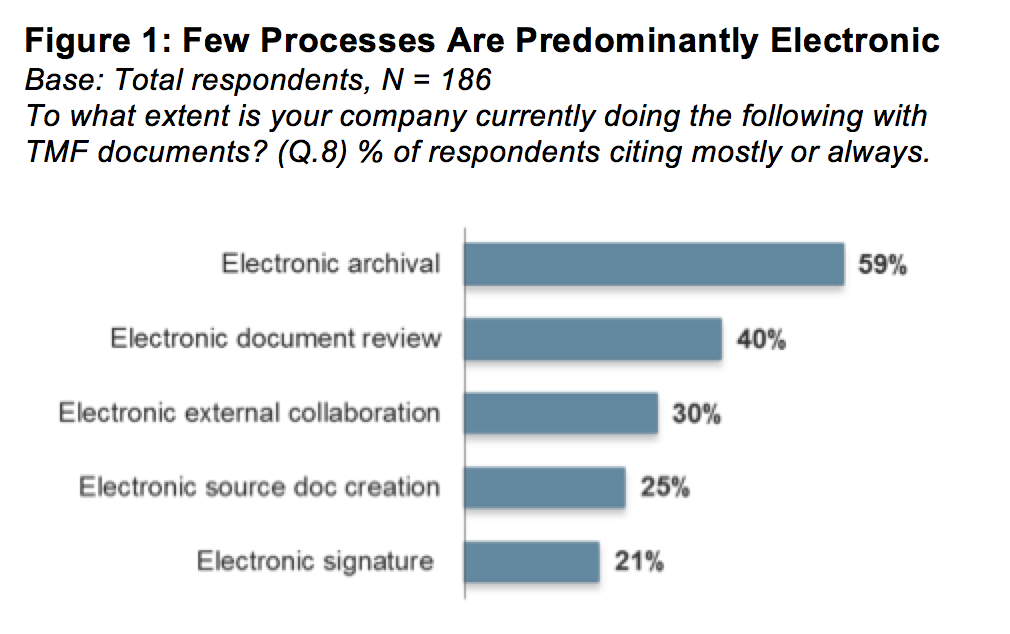New Research Shows Clinical Operations Moving to Electronic Processes, Industry on the Path to the Paperless Trial
WASHINGTON, DC – June 15, 2015 – New research shows life sciences organizations are increasing their use of advanced electronic trial master file (eTMF) applications and clinical operations departments are moving away from paper processes in managing their trial master file (TMF). Some business processes have been slower to make the move from paper, but TMF owners say barriers to conversion are low and increased use of electronic processes could speed time to market.
These are some of the findings of the Veeva 2015 Paperless TMF Survey: Annual Report, released today at the Drug Information Association’s (DIA) Annual Meeting. The global study of TMF owners found a striking reduction in paper used by clinical operations since 2014. Today, 31% of respondents are managing “most or all” TMF documents on paper, down 12 percentage points from 43% last year.
One in four respondents now report using eTMF applications to exchange TMF documents between sponsors and CROs, up nine percentage points from 2014. With the use of more advanced technology, trial sponsors and contract research organizations (CROs) are now relying considerably less on paper shipments and fax to exchange documents with sponsors, both down 10 percentage points in just one year.
“ClinOps is responsible for more than half of all documents in the TMF; therefore, their move off of paper is vital,” said Jennifer Goldsmith, vice president of Veeva Vault at Veeva Systems. “After moving to an electronic format, the next phase is implementing electronic processes. Not surprisingly, the first advances are in sponsor-CRO collaboration, which has been a significant pain point for many companies. When we look at the transformation in sponsor-CRO document exchange, we see significant, measurable progress.”

However, there is considerable variation in the adoption of eTMF processes. Less than one third of respondents are “mostly or always” using electronic methods for e-signature of documents (21%), electronic creation of source documents (25%), and electronic collaboration with external partners (30%).
The majority of respondents see benefits to shifting additional activities to electronic processes. For instance, 63% of those surveyed said they believe managing TMF filing in an eTMF would shorten development time, while 57% believe managing study/site start-up in an eTMF would shorten development time.
Given the growing expectations from health authorities like the Medicines and Healthcare Products Regulatory Agency (MHRA) around inspection readiness and TMF accessibility, the survey provides some positive indicators. Half of all eTMF users (49%) and 61% of those using eTMF applications cited improvements in inspection readiness due to using an eTMF. Users of eTMF applications are also more than twice as likely (57%) to grant auditors and inspectors remote access to the TMF than respondents as a whole (26%). Two-thirds (65%) of all respondents expect to grant remote access within the next two years.
The survey found only a small number of organizations (14%) are extensively using TMF data to improve trial processes. But as an increasing number of clinical documents are managed electronically, the use of metrics to improve study processes is expected to rise. Organizations that use eTMF applications or content management systems are more than twice as likely to extensively use metrics than those using less advanced cloud file share and local file systems.
“Despite reports that eTMF metrics lead to critical study process improvements, Veeva’s 2015 study reveals that most companies are still not actively using metrics,” said Linda Sullivan, chief operating officer of Metrics Champion Consortium, an association dedicated to standardized performance metrics. “As more data is collected over time and across multiple trials, it will be possible to identify important trends about study performance. The eTMF can inform business decisions by capturing an array of quality, performance, and operational metrics, internally and externally, across multiple sites and studies.”
The full results of the Veeva 2015 Paperless TMF Survey: Annual Benchmark will be presented at the DIA Annual Meeting on Tuesday, June 16 at 1 p.m. EDT in the Innovation Theater. DIA attendees can also visit Veeva’s booth, #1203, for a copy of the executive summary. The report is also available online at veeva.com/2015tmfsurvey.
Improving Relationships and Diversifying the Site Selection Process
April 17th 2025In this episode of the Applied Clinical Trials Podcast, Liz Beatty, co-founder and chief strategy officer, Inato, discusses a number of topics around site engagement including community-based sites, the role of technology in improving site/sponsor relationships, how increased operational costs are impacting the industry, and more.
Behind the Buzz: Why Clinical Research Leaders Flock to SCOPE Summit
February 7th 2025In this episode, we meet with Micah Lieberman, Executive Conference Director for SCOPE Summit (Summit for Clinical Ops Executives) at Cambridge Innovation Institute. We will dive deep into the critical role of collaboration within the clinical research ecosystem. How do we bring together diverse stakeholders—sponsors, CROs, clinical trial tech innovators, suppliers, patients, sites, advocacy organizations, investors, and non-profits—to share best practices in trial design, program planning, innovation, and clinical operations? We’ll explore why it’s vital for thought leaders to step beyond their own organizations and learn from others, exchanging ideas that drive advancements in clinical research. Additionally, we’ll discuss the pivotal role of scientific conferences like SCOPE Summit in fostering these essential connections and collaborations, helping shape the future of clinical trials. Join us as we uncover how collective wisdom and cross-industry partnerships are transforming the landscape of clinical research.